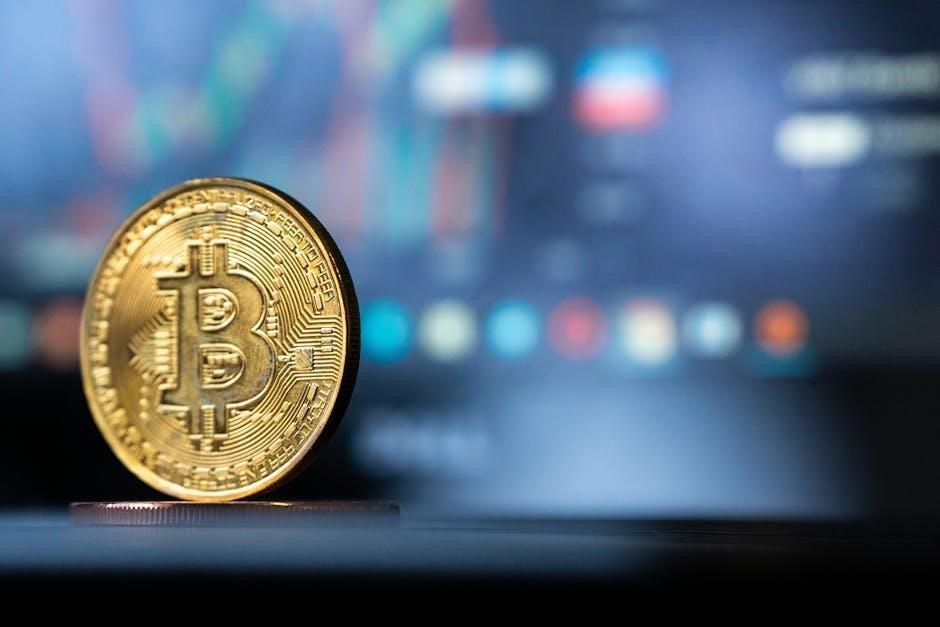Security tokens and stablecoins are transformative digital assets. Security tokens represent ownership in assets or entities, often regulated, while stablecoins are price-stable cryptocurrencies tied to fiat currencies, enabling seamless transactions and reducing volatility.
1.1 What Are Security Tokens?
Security tokens are digital assets representing ownership in securities, such as stocks, bonds, or real estate. They are issued on blockchain platforms, ensuring transparency and efficiency. Unlike traditional securities, they enable fractional ownership and global accessibility, while adhering to regulatory requirements. This innovation bridges traditional finance with decentralized technologies, offering new investment opportunities and liquidity.
1.2 What Are Stablecoins?
Stablecoins are cryptocurrencies designed to maintain a stable value relative to a fiat currency, such as the U.S. dollar. They mitigate volatility by being pegged to a reserve asset, offering price predictability. Common examples include Tether (USDT) and USD Coin (USDC). Stablecoins facilitate smooth transactions, cross-border payments, and act as a hedge against crypto market fluctuations, enhancing financial stability.
1.3 Key Differences Between Security Tokens and Stablecoins
Security tokens represent ownership in assets or entities, offering investment opportunities, while stablecoins are price-stable cryptocurrencies pegged to fiat currencies, ensuring transactional stability. Security tokens are regulated financial instruments, whereas stablecoins focus on mitigating crypto volatility. Their purposes differ: security tokens enable fractional ownership and investment, while stablecoins facilitate everyday transactions and cross-border payments efficiently.

Benefits of Security Tokens
Security tokens offer fractional ownership, enabling investors to access high-value assets; They provide regulatory compliance, reducing legal risks, and open up new investment opportunities globally, fostering financial inclusion.
2.1 Investment Opportunities
Security tokens unlock diverse investment opportunities by fractionalizing assets like real estate, private equity, and fine art. This allows investors to access traditionally illiquid markets with lower capital requirements, creating a more inclusive financial ecosystem. Additionally, tokenized assets can be traded globally, enhancing liquidity and attracting a broader range of investors.
2.2 Regulatory Compliance
Security tokens operate within established legal frameworks, ensuring compliance with securities laws. This includes adhering to regulations like Know Your Customer (KYC) and Anti-Money Laundering (AML), which build investor trust and mitigate risks. Stablecoins, while not typically classified as securities, face regulatory scrutiny regarding currency issuance and consumer protection, ensuring transparency and stability in their operations.
2.3 Fractional Ownership
Security tokens enable fractional ownership, allowing multiple investors to own a portion of an asset. This increases accessibility and affordability, as high capital requirements are reduced. Blockchain technology ensures transparent and secure transactions, making fractional ownership a key advantage for democratizing investment opportunities across various asset classes, including real estate and businesses.

Benefits of Stablecoins
Stablecoins offer price stability and reliability, making them ideal for everyday transactions and cross-border payments. They also serve as a hedge against cryptocurrency market volatility.
3.1 Price Stability
Stablecoins maintain a consistent value, typically pegged to fiat currencies like the US dollar, reducing price fluctuations. This stability makes them reliable for transactions, storing value, and avoiding cryptocurrency volatility risks. Their predictable value ensures smoother financial planning and operational efficiency in various economic activities.
3.2 Cross-Border Transactions
Stablecoins simplify cross-border transactions by enabling efficient, low-cost transfers of value globally. They eliminate the need for intermediaries, reducing fees and processing times. This makes stablecoins ideal for international trade and remittances, ensuring seamless and reliable transactions across borders with minimal friction and maximum efficiency.
3.3 Hedge Against Volatility
Stablecoins offer a reliable hedge against cryptocurrency market volatility by maintaining a stable value pegged to fiat currencies. Investors use them to safeguard portfolios during market fluctuations, ensuring liquidity and reducing exposure to unpredictable asset swings. This stability makes stablecoins a crucial tool for risk management in the volatile crypto landscape.

How to Get Started with Security Tokens
Getting started with security tokens involves understanding market dynamics, ensuring regulatory compliance, selecting trusted platforms, and conducting thorough due diligence to mitigate risks and maximize opportunities.
4.1 Understanding Regulations
Understanding regulations is crucial for security tokens. They often fall under securities laws, requiring compliance with frameworks like SEC guidelines in the U.S. or similar bodies globally. This ensures legal issuance and trading, protecting both issuers and investors while maintaining market integrity and transparency.
4.2 Choosing the Right Platform
Selecting the right platform for security tokens involves evaluating factors like compliance, scalability, and investor accessibility. Popular platforms include Polymath, Harbor, and Securitize, which offer robust tools for issuance and management. Ensure the platform aligns with your business needs and supports necessary regulatory requirements, providing a secure and efficient experience for both issuers and investors.
4.3 Conducting Due Diligence
Conducting thorough due diligence is crucial when engaging with security tokens. Investors should research the issuer’s background, financial stability, and legal compliance. Review project whitepapers, assess market potential, and evaluate risk factors. Additionally, understanding the regulatory environment and ensuring the platform’s security measures are in place can mitigate potential risks and safeguard investments effectively.

How to Get Started with Stablecoins
Stablecoins are cryptocurrencies pegged to fiat currencies, offering price stability. They simplify transactions, reduce volatility, and enable seamless cross-border payments, making them ideal for everyday use and DeFi applications.
5.1 Selecting the Right Stablecoin
Selecting the right stablecoin involves evaluating factors like the underlying collateral, regulatory compliance, and market liquidity. Popular options include USDT, USDC, and BUSD, each offering stability and ease of use in transactions and DeFi activities. Ensure the stablecoin aligns with your financial goals and risk tolerance for optimal results.
5.2 Setting Up a Digital Wallet
Setting up a digital wallet is essential for managing stablecoins. Choose a reputable wallet like MetaMask or Coinbase, ensuring compatibility with your preferred stablecoin. Enable two-factor authentication for security. Carefully follow setup instructions to securely store, send, and receive stablecoins, ensuring your assets are protected and easily accessible for transactions.
5.3 Understanding Trading Pairs
Trading pairs are combinations of assets traded against each other. For stablecoins, common pairs include USDT/ETH or DAI/BTC. Understanding these pairs is crucial for executing transactions, as they dictate exchange rates and liquidity. Familiarizing yourself with trading pairs helps optimize your stablecoin transactions and portfolio management in decentralized finance (DeFi) ecosystems.

Use Cases for Security Tokens
Security tokens enable fractional ownership, streamline fundraising, and provide liquidity for traditionally illiquid assets like real estate or fine art, transforming capital markets.
6.1 Fundraising for Businesses
Security tokens revolutionize corporate fundraising by enabling businesses to raise capital directly through tokenized assets. This method bypasses traditional intermediaries, offering fractional ownership and real-time tracking of investments. Companies can attract global investors, enhancing liquidity and accessibility. This model is particularly beneficial for real estate, startups, and other ventures seeking efficient, cost-effective funding solutions.
6.2 Real Estate Investment
Security tokens transform real estate investment by enabling fractional ownership of properties. Investors can purchase tokenized shares, lowering entry barriers and increasing accessibility. This model streamlines transactions, reduces costs, and allows global participation. Stablecoins further enhance transactions by providing price stability, making real estate investments more attractive and reducing volatility risks for participants.
6.3 Equity and Debt Financing
Security tokens revolutionize equity and debt financing by enabling companies to raise capital through tokenized assets. Investors can purchase tokens representing ownership shares or debt obligations, enhancing liquidity and accessibility. This method streamlines transactions, reduces costs, and improves transparency. Stablecoins can further facilitate these financings by stabilizing payments and reducing volatility risks for all parties involved.

Use Cases for Stablecoins
Stablecoins enable everyday transactions, facilitate cross-border payments, and provide a hedge against cryptocurrency volatility. They are widely used in DeFi for lending, trading, and as collateral, enhancing financial accessibility and efficiency globally.
7.1 Everyday Transactions
Stablecoins are ideal for everyday transactions due to their price stability, reducing volatility risks. They enable seamless purchases of goods and services, making them a practical choice for routine expenses like groceries or bills. Their stability encourages merchant acceptance, fostering wider adoption and reliability for consistent purchasing power in daily life.
7.2 Decentralized Finance (DeFi)
Stablecoins play a crucial role in DeFi, enabling lending, borrowing, and trading without volatility risks. Platforms like MakerDAO and Aave utilize stablecoins to provide financial services, allowing users to earn interest or take loans. This stability fosters growth in DeFi, making it accessible for broader adoption and innovation in decentralized financial ecosystems.
7.3 Cross-Border Payments
Stablecoins simplify cross-border payments by eliminating exchange rate risks and high fees. They enable fast, secure transactions globally, making them ideal for international trade and remittances. This efficiency reduces costs and increases accessibility, fostering financial inclusion and global economic opportunities through blockchain technology.
Regulatory Environment
The regulatory environment for security tokens and stablecoins involves oversight by financial authorities, balancing innovation with investor protection and market stability, while addressing global compliance challenges.
8.1 Security Token Regulations
Security token regulations vary globally, with jurisdictions like the U.S. classifying them as securities under SEC oversight. Compliance with investor protection laws, transparency, and adherence to financial regulations are crucial. These rules aim to balance innovation with market integrity, ensuring fair practices while safeguarding investors’ interests in the evolving digital asset landscape.
8.2 Stablecoin Regulations
Stablecoin regulations are rapidly evolving, with focus on ensuring price stability and consumer protection. Authorities worldwide, like the EU with MiCA, are implementing frameworks to oversee issuance, collateral requirements, and transparency. In the U.S., regulatory scrutiny emphasizes compliance with financial laws, while global standards aim to address risks like systemic instability and maintain market integrity.
8.3 Global Compliance Challenges
Global compliance challenges for security tokens and stablecoins include navigating diverse regulatory frameworks across jurisdictions. Each country has unique requirements, creating complexities for cross-border operations. Ensuring compliance with anti-money laundering and know-your-customer laws while maintaining operational efficiency is crucial. Harmonizing international standards and addressing tax implications are key hurdles for widespread adoption.

Technology Behind Security Tokens and Stablecoins
The backbone of security tokens and stablecoins is blockchain technology, enabling secure, transparent transactions. Smart contracts automate enforcement of rules, while tokenization allows digital representation of assets.
9.1 Blockchain Platforms
Blockchain platforms like Ethereum and Polkadot serve as the foundation for creating and managing security tokens and stablecoins. These platforms provide decentralized networks, enabling secure, transparent, and efficient transactions. They also support smart contracts, which automate the enforcement of rules and regulations, ensuring compliance and trust within the ecosystem.
9.2 Smart Contracts
Smart contracts are self-executing agreements with predefined rules, automating processes like token issuance and transactions. They eliminate intermediaries, ensuring transparency and security. For security tokens, smart contracts enforce regulatory compliance, while for stablecoins, they maintain price stability by automating collateralization and redemption processes, ensuring trust and efficiency in decentralized systems.
9.3 Tokenization Process
Tokenization converts traditional assets into digital tokens on a blockchain, enabling secure and efficient transactions. For security tokens, it involves defining asset terms, choosing a platform, and issuing tokens through STOs. Stablecoins are tokenized fiat currencies, using collateral and smart contracts to maintain value stability, ensuring seamless and reliable transactions in decentralized ecosystems.

Security and Risks
Security tokens and stablecoins face risks like hacking, smart contract vulnerabilities, and regulatory challenges. Implementing robust security practices, such as encryption and secure wallets, is crucial to mitigate these risks.
10.1 Security Best Practices
Adopting security best practices is essential for safeguarding security tokens and stablecoins. Enable two-factor authentication, use hardware wallets, and ensure all transactions are encrypted. Regularly update software and avoid phishing scams to protect digital assets from unauthorized access and potential breaches. Additionally, conduct thorough due diligence on platforms and verify smart contract audits to ensure security.
10.2 Common Risks
Common risks include market volatility, smart contract vulnerabilities, and regulatory uncertainties. Stablecoins may depeg from their fiat counterparts, while security tokens face investment losses and liquidity risks. Additionally, hacking incidents and phishing attacks pose significant threats. Understanding these risks is crucial for safeguarding digital assets and ensuring secure transactions in the crypto space.
10.3 Mitigation Strategies
To mitigate risks, adopt robust security practices like multi-factor authentication and hardware wallets. Regularly audit smart contracts and diversify investments. Stay informed about regulatory changes and market trends. Use reputable platforms and conduct thorough due diligence. Implementing these strategies can enhance security and reduce exposure to potential threats in the crypto ecosystem.

Future Outlook
The future of security tokens and stablecoins looks promising, with growing adoption, regulatory clarity, and technological advancements driving their evolution in the financial landscape.
11.1 Evolution of Security Tokens
Security tokens are advancing rapidly, with improvements in blockchain technology and regulatory frameworks. They now enable fractional ownership, streamline transactions, and offer enhanced transparency. Smart contracts automate compliance, reducing counterparty risks and increasing efficiency. As adoption grows, security tokens are reshaping traditional financial markets, making them more accessible and secure for global investors.
11.2 Growth of Stablecoins
Stablecoins are experiencing rapid growth, driven by their role in DeFi and cross-border payments. Their surge in popularity reflects increasing demand for price-stable digital assets. Regulatory clarity and technological advancements are further fueling their adoption, making stablecoins a cornerstone of the evolving cryptocurrency ecosystem.
11.3 Industry Predictions
Industry experts predict that security tokens and stablecoins will see mainstream adoption as regulatory frameworks mature. This growth will be driven by increasing institutional interest and the integration of blockchain technology into traditional financial systems. Advancements in tokenization platforms and stablecoin innovations will further solidify their roles in the financial ecosystem.
Security tokens and stablecoins are revolutionizing finance by combining blockchain innovation with traditional assets. Their growth promises enhanced accessibility, efficiency, and stability, reshaping global financial ecosystems.
12.1 Summary of Key Points
Security tokens and stablecoins are transforming finance by enabling fractional ownership, regulatory compliance, and price stability. They facilitate investment, cross-border transactions, and hedge against volatility, supported by blockchain technology and smart contracts, while adhering to evolving regulations, making them crucial for modern financial systems and decentralized applications.
12.2 Final Thoughts
Security tokens and stablecoins are revolutionizing finance, offering innovative solutions for investment, transactions, and financial inclusion. Their growth underscores the potential to reshape traditional systems, emphasizing the need for awareness and adaptation in this evolving landscape. Embracing these technologies wisely can unlock significant opportunities in the digital economy.